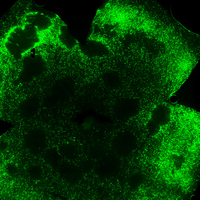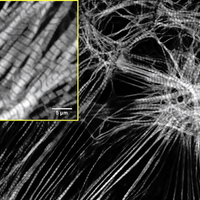Login
Subscribegenetics & genomics, cell & molecular biology, genetics

Lottery Underway for Rare Muscle-Wasting Disease Gene Therapy
Lisa Winter | Jan 7, 2020 | 2 min read
The announcement by Novartis, the maker of Zolgensma, has drawn mixed reactions from the spinal muscular atrophy community.

Circulating Fetal Cells Sequenced for Prenatal Testing Study
Emily Makowski | Dec 10, 2019 | 3 min read
Trophoblasts, collected from the mother during a blood draw, can determine fetal genetic abnormalities currently diagnosed through amniocentesis or chorionic villi sampling.

Spaceflight Alters Genes of Human Stem Cell–Derived Heart Cells
Emily Makowski | Nov 7, 2019 | 3 min read
Cardiomyocytes made from iPSCs aboard the International Space Station had upregulated mitochondrial functioning.

Image of the Day: Cone Preservation
Chia-Yi Hou | Apr 30, 2019 | 1 min read
Researchers treat mice with retinitis pigmentosa using a gene therapy that reduces cone loss.

The Dark Matter of the Human Proteome
Annie Rathore | Apr 1, 2019 | 10 min read
Advances in the functional characterization of newly discovered microproteins hint at diverse roles in health and disease.

Some Viruses May Infect by Inserting Different Portions of Genetic Material
Emma Yasinski | Mar 18, 2019 | 3 min read
Viruses that infect plants and occasionally insects appear to cause infection with a divide-and-conquer strategy, multiplying separate segments of genetic material in different host cells.

Without This Enzyme, Insertions Thrive in the Yeast Genome
Katarina Zimmer | Mar 1, 2019 | 3 min read
A study underscores the importance of Dna2 in maintaining the integrity of the genetic code.

Infographic: How Stray DNA Can Land in Double-Strand Breaks
Katarina Zimmer | Mar 1, 2019 | 1 min read
A study on yeast illuminates how insertions may occur.

HeLa Cells from Different Labs Vary in Genetics, Phenotype
Katarina Zimmer | Feb 26, 2019 | 4 min read
This could account for some reproducibility problems in cell line research, according to the authors of a comprehensive analysis of HeLa variants.

A New Role for Yeast Introns: Helping Cells Cope Under Stress
Katarina Zimmer | Jan 16, 2019 | 4 min read
Two studies contest the idea that the noncoding sequences are just “junk DNA,” demonstrating that they play important roles in the regulation of cell growth.

Researchers Engineer Epigenome Editors to Study How Gene Expression Affects Disease
Ashley Yeager | Jan 1, 2019 | 7 min read
Using CRISPR and other tools, scientists are modifying DNA methylation, histone marks, and other modifiers of gene expression to understand how they affect health and disease.

Image of the Day: Beating Heart
Sukanya Charuchandra | Jul 2, 2018 | 1 min read
Scientists at the Allen Institute for Cell Science have developed an open-source stem cell line with fluorescent tags for cardiac cells.

Youssef Belkhadir Deciphers Plants’ Signaling Soundtrack
Ashley Yeager | Jun 1, 2018 | 3 min read
An entrepreneurial attitude helped this Vienna-based researcher begin to unravel the complex receptor network that Arabidopsis uses to develop and defend itself.

Base Editing Now Able to Convert Adenine-Thymine to Guanine-Cytosine
Catherine Offord | Oct 25, 2017 | 8 min read
With the arrival of a new class of single-nucleotide editors, researchers can target the most common type of pathogenic SNP in humans.

Twists and Turns
Mary Beth Aberlin | Jul 16, 2017 | 3 min read
New starring roles for nucleic acids

Molecular Trigger for Organ Rejection in Mice Identified
Diana Kwon | Jun 27, 2017 | 2 min read
The cell-surface receptor, SIRP-alpha, initiates the innate immune response in hosts.

Valerie Horsley Gets Under Skin
Kerry Grens | May 1, 2017 | 3 min read
The Yale University cell and molecular biologist is probing the deep mysteries of epidermal cells.

Creating a DNA Record with CRISPR
Ruth Williams | Jun 9, 2016 | 3 min read
Researchers repurpose a bacterial immune system to be a molecular recording device.

More Than Skin Deep
Anna Azvolinsky | May 1, 2016 | 9 min read
Elaine Fuchs has worked on adult stem cells since before they were so named, figuring out how multipotent epidermal cells renew or turn into skin or hair follicles.
